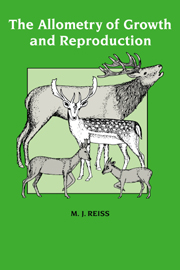Book contents
- Frontmatter
- Contents
- Preface
- 1 Introduction
- 2 The scaling of average daily metabolic rate and energy intake
- 3 Why do larger species invest relatively less in their offspring?
- 4 The intraspecific relationship of parental investment to female body weight
- 5 Growth and productivity
- 6 Quantitative models of body size
- 7 Sexual dimorphism in body size
- 8 Are larger species more dimorphic in body size?
- 9 Surface area/volume arguments in biology
- 10 Prospectus
- Glossary of mathematical terms
- References
- Index
9 - Surface area/volume arguments in biology
Published online by Cambridge University Press: 02 December 2009
- Frontmatter
- Contents
- Preface
- 1 Introduction
- 2 The scaling of average daily metabolic rate and energy intake
- 3 Why do larger species invest relatively less in their offspring?
- 4 The intraspecific relationship of parental investment to female body weight
- 5 Growth and productivity
- 6 Quantitative models of body size
- 7 Sexual dimorphism in body size
- 8 Are larger species more dimorphic in body size?
- 9 Surface area/volume arguments in biology
- 10 Prospectus
- Glossary of mathematical terms
- References
- Index
Summary
Surface area/volume arguments have been extensively used in biology. They are valid provided, first, that one of the properties being considered scales as the surface area of an organism and the other as the volume of an organism and, secondly, given that this is the case, that the surface area/volume ratio represents an important evolutionary constraint pertinent to the problem under consideration.
This chapter looks at some instances where surface area/volume arguments may have been misappropriated or misapplied. It also considers when they may be valid.
Why cannot large animals rely solely on diffusion for gaseous exchange?
The universal answer given in school (Mackean, 1973; Revised Nuffield Biology, 1975; Soper & Tyrell Smith, 1979; Rowlinson & Jenkins, 1982; Jones & Jones, 1984; Green, Stout & Taylor, 1984; Roberts, 1986a, b; Hill & Holman, 1986) and university (Marshall & Hughes, 1965; Barrington, 1967; Alexander, 1971, 1979; Barnes, 1974; Bligh, Cloudsley-Thompson & MacDonald, 1976; Schmidt-Nielsen, 1983, 1984) text-books to the question ‘Why do large species of animals have lungs, gills or other structures specialized for gaseous exchange while smaller species manage by diffusion’ is that the larger an organism, the smaller its surface area to volume ratio. This answer makes two implicit assumptions. First, that the oxygen requirements of an animal are proportional to its volume or weight. Secondly, that diffusion can only provide oxygen at a rate proportional to an animal's surface area. The former of these assumptions is incorrect (Reiss, 1987b). The oxygen requirements of animals scale on body weight with exponents of less than one.
- Type
- Chapter
- Information
- The Allometry of Growth and Reproduction , pp. 129 - 138Publisher: Cambridge University PressPrint publication year: 1989



